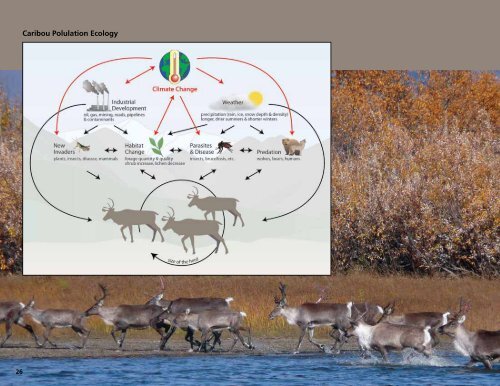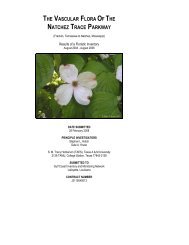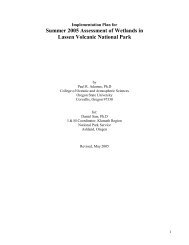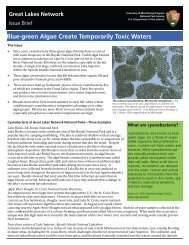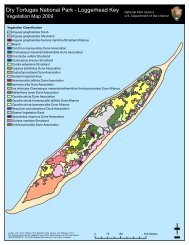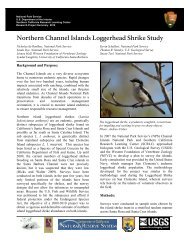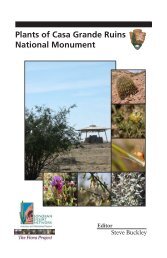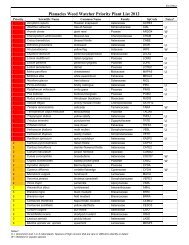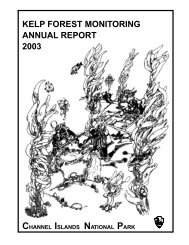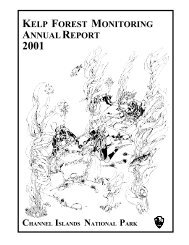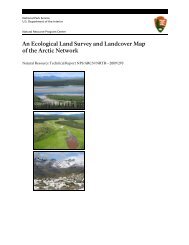Complexity of Caribou Population Dynamics in a Changing Climate
Complexity of Caribou Population Dynamics in a Changing Climate
Complexity of Caribou Population Dynamics in a Changing Climate
Create successful ePaper yourself
Turn your PDF publications into a flip-book with our unique Google optimized e-Paper software.
26<br />
<strong>Caribou</strong> Polulation Ecology
Alaska Park Science, Volume 10, Issue 1<br />
<strong>Complexity</strong> <strong>of</strong> <strong>Caribou</strong> <strong>Population</strong> <strong>Dynamics</strong> <strong>in</strong> a Chang<strong>in</strong>g <strong>Climate</strong><br />
By Kyle Joly and David R. Kle<strong>in</strong><br />
Vast, migrat<strong>in</strong>g herds <strong>of</strong> caribou are an iconic image<br />
<strong>of</strong> the North. Yet, there is concern that a chang<strong>in</strong>g<br />
climate may drive this magnificent species the way <strong>of</strong> the<br />
Great Pla<strong>in</strong>s bison. The complexity that characterizes<br />
the ecology <strong>of</strong> caribou <strong>in</strong>cludes their extreme <strong>in</strong>terconnectedness<br />
with other ecosystem components, <strong>in</strong>clud<strong>in</strong>g<br />
thousands <strong>of</strong> years <strong>of</strong> <strong>in</strong>teractions with humans.<br />
Numbers <strong>of</strong> caribou naturally oscillate <strong>in</strong> dramatic<br />
fashion on the time-scale <strong>of</strong> decades (Gunn 2003). Key<br />
<strong>in</strong>fluences driv<strong>in</strong>g population dynamics <strong>in</strong>clude climate,<br />
habitat, predation, parasites, <strong>in</strong>sects and diseases, human<br />
<strong>in</strong>fluences, <strong>in</strong>vasive species, competition, stochastic<br />
events, and the caribou themselves (Figure 1). The relative<br />
<strong>in</strong>fluence <strong>of</strong> each factor varies throughout the vast<br />
range <strong>of</strong> the genus Rangifer (both re<strong>in</strong>deer and caribou,<br />
hereafter referred to as caribou). Humans affect caribou<br />
through hunt<strong>in</strong>g, disturbance, <strong>in</strong>dustrial pollution,<br />
facilitat<strong>in</strong>g <strong>in</strong>vasive species and re<strong>in</strong>deer graz<strong>in</strong>g. While<br />
human <strong>in</strong>fluence is <strong>in</strong>creas<strong>in</strong>g <strong>in</strong> the Arctic, it is much<br />
greater <strong>in</strong> the southern areas <strong>of</strong> caribou distribution.<br />
Figure 1. A graphic model illustrat<strong>in</strong>g the complexity <strong>of</strong><br />
caribou population ecology under the <strong>in</strong>fluences <strong>of</strong> a<br />
chang<strong>in</strong>g climate.<br />
Designed by L. Weaver<br />
Figure 2. Shrubs are expected to <strong>in</strong>crease <strong>in</strong> the range <strong>of</strong><br />
caribou under most climate change scenarios. This could<br />
benefit them <strong>in</strong> summer by <strong>in</strong>creas<strong>in</strong>g forage, but caribou<br />
<strong>of</strong>ten avoid dense brush because <strong>of</strong> predators and low<br />
lichen abundance.<br />
NPS photograph by K. Joly<br />
The southern extent is where populations have been<br />
extirpated and most endangered populations reside<br />
(Hebblewhite et al. 2010). Our goal is to expla<strong>in</strong>, with<strong>in</strong> the<br />
limits <strong>of</strong> our present understand<strong>in</strong>g, how the chang<strong>in</strong>g<br />
climate can be expected to <strong>in</strong>fluence caribou populations<br />
through its affect on these primary <strong>in</strong>fluences.<br />
<strong>Climate</strong>, Stochastic Events, Parasites, Insects<br />
and Diseases<br />
<strong>Climate</strong> is an ultimate driver <strong>in</strong>fluenc<strong>in</strong>g caribou<br />
population ecology by directly affect<strong>in</strong>g growth, quantity<br />
and nutritional quality <strong>of</strong> forage plants forage; through<br />
its <strong>in</strong>fluence on <strong>in</strong>sects that harass and parasitize<br />
caribou <strong>in</strong> summer; through its control over snow<br />
characteristics that determ<strong>in</strong>e forage accessibility <strong>in</strong><br />
w<strong>in</strong>ter; and the vulnerability <strong>of</strong> caribou to predation.<br />
Subcomponents <strong>of</strong> the climate system, namely snow,<br />
ic<strong>in</strong>g, ra<strong>in</strong>, solar <strong>in</strong>put, temperature, w<strong>in</strong>d, clouds,<br />
and seasonality, vary dramatically <strong>in</strong> their importance<br />
to the ecology <strong>of</strong> different caribou populations.<br />
Snow is present dur<strong>in</strong>g a major portion <strong>of</strong> the year<br />
with<strong>in</strong> all caribou ranges. The greatest depths are <strong>in</strong> the<br />
temperate, moist mounta<strong>in</strong>ous regions <strong>of</strong> southwest<br />
Canada, and the lowest are <strong>in</strong> the polar deserts <strong>of</strong> the<br />
High Arctic. Greater snow depth <strong>in</strong>creases the energy<br />
expended for movement and to reach w<strong>in</strong>ter forage<br />
species such as ground-dwell<strong>in</strong>g lichens (Fancy and<br />
White 1985), which can contribute to poor body condition<br />
and greater vulnerability to predation. Snow can also<br />
<strong>in</strong>fluence the tim<strong>in</strong>g <strong>of</strong> green up, which may have serious<br />
nutritional and reproductive consequences. Deep snow<br />
years have been associated with poor physiological<br />
condition <strong>of</strong> cows <strong>in</strong> spr<strong>in</strong>g, lower calf birth weights,<br />
reduced calf survival, slower growth <strong>of</strong> surviv<strong>in</strong>g<br />
calves, poor body condition <strong>of</strong> calves enter<strong>in</strong>g w<strong>in</strong>ter,<br />
reduced pregnancy rates the follow<strong>in</strong>g year, and delayed<br />
parturition the follow<strong>in</strong>g spr<strong>in</strong>g (Adams et al. 2006).<br />
Ic<strong>in</strong>g or ra<strong>in</strong> on snow events that restrict forage access<br />
are more critical to northern populations <strong>of</strong> caribou,<br />
which are reliant upon ground-dwell<strong>in</strong>g lichens <strong>in</strong> w<strong>in</strong>ter,<br />
<strong>in</strong> contrast to southern populations that rely primarily<br />
on arboreal lichens. Similarly, w<strong>in</strong>d can be detrimental<br />
to caribou by harden<strong>in</strong>g the snowpack, restrict<strong>in</strong>g access<br />
to w<strong>in</strong>ter forage (Fancy and White 1985) or <strong>in</strong>creas<strong>in</strong>g<br />
energy costs <strong>of</strong> thermoregulation for young caribou after<br />
calv<strong>in</strong>g or for all caribou dur<strong>in</strong>g extreme cold. However,<br />
w<strong>in</strong>d can blow snow clear mak<strong>in</strong>g it easier to access<br />
forage and evade predation. In summer, w<strong>in</strong>dy locations<br />
are sought to reduce <strong>in</strong>sect harassment. Ra<strong>in</strong> can also<br />
directly affect thermoregulation <strong>in</strong> calves, <strong>in</strong>fluence<br />
growth <strong>of</strong> forage species, as well as the prevalence<br />
<strong>of</strong> wildfire upon the landscape (Duffy et al. 2005).<br />
The presence and extent <strong>of</strong> cloud cover, through its<br />
<strong>in</strong>fluence on solar <strong>in</strong>solation and temperatures at ground<br />
level, can affect caribou either directly or <strong>in</strong>directly.<br />
Cloud cover <strong>in</strong> summer usually is associated with cool<br />
ambient temperatures, and thus, reduced activity <strong>of</strong><br />
<strong>in</strong>sects, especially mosquitoes, allow<strong>in</strong>g for <strong>in</strong>creased<br />
time available for optimal forag<strong>in</strong>g by caribou (Moerschel<br />
and Kle<strong>in</strong> 1997) and a prolong<strong>in</strong>g <strong>of</strong> peak summer<br />
forage quality (Bø and Hjeljord 1991). Precipitation,<br />
temperature, w<strong>in</strong>ds and clouds can all be affected by<br />
large-scale, long-lived climate patterns, such as the Pacific<br />
Decadal Oscillation (Hartmann and Wendler 2005).<br />
Seasonality, a function <strong>of</strong> climate, is the overrid<strong>in</strong>g<br />
annual variable <strong>in</strong>fluenc<strong>in</strong>g caribou ecosystem compo-<br />
27
28<br />
<strong>Complexity</strong> <strong>of</strong> <strong>Caribou</strong> <strong>Population</strong> <strong>Dynamics</strong> <strong>in</strong> a Chang<strong>in</strong>g <strong>Climate</strong><br />
Figure 3. Western Arctic Herd caribou <strong>in</strong> Kobuk Valley<br />
National Park. Warmer temperatures <strong>in</strong> w<strong>in</strong>ter and spr<strong>in</strong>g<br />
could lead to more dangerous cross<strong>in</strong>gs <strong>of</strong> rivers and lakes<br />
that have been frozen solid <strong>in</strong> previous years.<br />
nents. Quantity and quality <strong>of</strong> forage species are governed<br />
by the rate <strong>of</strong> summer growth, whereas <strong>in</strong> w<strong>in</strong>ter, snow<br />
depth and density conditions alter availability <strong>of</strong> forage.<br />
Variables <strong>in</strong> summer weather <strong>in</strong>fluence the <strong>in</strong>tensity<br />
and duration <strong>of</strong> <strong>in</strong>sect harassment. Fall is the period<br />
when caribou must replenish their energy and prote<strong>in</strong><br />
reserves before fac<strong>in</strong>g the long w<strong>in</strong>ter when prote<strong>in</strong>rich<br />
forage is limited. Fall body condition is a strong<br />
determ<strong>in</strong>ant <strong>of</strong> pregnancy rates (Cameron et al. 1993).<br />
Climatic conditions also strongly affect the distribution<br />
and abundance <strong>of</strong> parasites, <strong>in</strong>sects and diseases that<br />
exert vary<strong>in</strong>g levels <strong>of</strong> <strong>in</strong>fluence on caribou population<br />
dynamics. The importance <strong>of</strong> these <strong>in</strong>fluences decl<strong>in</strong>e<br />
with latitude. Increased movements, due to <strong>in</strong>sect<br />
harassment, have been l<strong>in</strong>ked to reduced growth <strong>of</strong><br />
caribou calves over summer (Couturier et al. 2009). A suite<br />
<strong>of</strong> diseases and parasites can negatively affect caribou<br />
body condition, <strong>in</strong>fluenc<strong>in</strong>g their ability to survive<br />
and reproduce, cause mortality or loss <strong>of</strong> the fetus.<br />
<strong>Climate</strong> change is expected to modify current patterns<br />
<strong>of</strong> snow, ic<strong>in</strong>g, ra<strong>in</strong>, temperature, w<strong>in</strong>d, clouds, and<br />
seasonality with<strong>in</strong> the range <strong>of</strong> caribou. Temperatures<br />
NPS photograph by K. Joly<br />
Figure 4. A summer wildfire where caribou overw<strong>in</strong>ter. Warmer, drier conditions <strong>in</strong> the future could lead to more wildfire <strong>in</strong><br />
both boreal forest and tundra ecosystems. Lichens, an important w<strong>in</strong>ter forage for many caribou herds, can take many decades<br />
to recover to previous levels follow<strong>in</strong>g burn<strong>in</strong>g.<br />
are predicted to <strong>in</strong>crease under all climate change<br />
scenarios, rais<strong>in</strong>g a suite <strong>of</strong> problems for caribou. Warm<strong>in</strong>g<br />
<strong>in</strong>creases summer forage quantity but can reduce its<br />
quality (Callaghan et al. 2004), while quantity <strong>of</strong> lichens<br />
is reduced (Joly et al. 2009). Conversely, caribou will<br />
presumably benefit from shorter w<strong>in</strong>ters, with lower<br />
energy costs for w<strong>in</strong>ter activities and body ma<strong>in</strong>tenance.<br />
Warmer w<strong>in</strong>ters may allow for greater <strong>in</strong>-season snow<br />
melt, which also may be beneficial for caribou (Tyler et<br />
al. 2008). Dryer conditions <strong>in</strong> summer are expected to<br />
result <strong>in</strong> <strong>in</strong>creased prevalence <strong>of</strong> wildfire (Duffy et al.<br />
2005). <strong>Caribou</strong> are known to avoid burned w<strong>in</strong>ter habitat<br />
for decades, both <strong>in</strong> the tundra and boreal forest, (Joly et<br />
al. 2007) likely due to the destruction <strong>of</strong> forage lichens,<br />
which can take up to a century or more to recover.<br />
Thus, fire can <strong>in</strong>fluence the nutrition and movements<br />
NPS photograph by K. Joly
<strong>of</strong> caribou and <strong>in</strong> turn affect their population dynamics.<br />
Even small <strong>in</strong>creases <strong>in</strong> temperature and grow<strong>in</strong>g season<br />
will dramatically <strong>in</strong>crease the abundance, global distribution<br />
and impacts <strong>of</strong> parasites, <strong>in</strong>sects and diseases.<br />
Variation <strong>in</strong> other climate subcomponents due to<br />
climate change cannot be reliably predicted at this po<strong>in</strong>t.<br />
Given the extent <strong>of</strong> predicted warm<strong>in</strong>g, drier conditions<br />
are expected to occur even if precipitation does <strong>in</strong>crease.<br />
Significant signs <strong>of</strong> dry<strong>in</strong>g (e.g., decl<strong>in</strong>es <strong>in</strong> vegetative productivity)<br />
<strong>in</strong> the boreal forest have already been detected<br />
(Verbyla 2008). Increased summer w<strong>in</strong>ds could help<br />
reduce <strong>in</strong>sect harassment <strong>in</strong> summer or scour snow from<br />
elevated terra<strong>in</strong> expos<strong>in</strong>g forage plants <strong>in</strong> w<strong>in</strong>ter, and thus<br />
be beneficial to caribou. Increased w<strong>in</strong>d can act to harden<br />
snow, which would be detrimental to caribou. Increased<br />
clouds reduces vegetative productivity, but would extend<br />
the length <strong>of</strong> peak nutritional quality <strong>of</strong> some forage<br />
species (Bø and Hjeljord 1991), which would be beneficial<br />
for caribou. Earlier spr<strong>in</strong>g green up and access to<br />
highly digestible forage may or may not benefit caribou.<br />
Stochastic events, such as avalanches and drown<strong>in</strong>gs<br />
(due to flood conditions or th<strong>in</strong> ice), will have vary<strong>in</strong>g<br />
degrees <strong>of</strong> <strong>in</strong>fluence but will likely be greater on smaller<br />
herds. Stochastic events, such as flood<strong>in</strong>g, drought and<br />
extreme storms, are predicted to <strong>in</strong>crease under climate<br />
change scenarios, which would be detrimental to caribou.<br />
Habitat, Human Influences, Density-dependent<br />
Factors and Competition<br />
Habitat, encompass<strong>in</strong>g areal extent, topography,<br />
vegetation, forage quantity, forage quality and forage<br />
availability, is a key <strong>in</strong>fluence on the population ecology<br />
<strong>of</strong> all species. Total available habitat can be an important<br />
and obvious <strong>in</strong>fluence on population dynamics where<br />
density <strong>of</strong> humans is high. Topography affects vegetation<br />
as well as precipitation, w<strong>in</strong>d, temperature and phenology,<br />
and thus plays an important role <strong>in</strong> caribou ecology.<br />
Vegetation is crucial because caribou must travel through,<br />
exist <strong>in</strong> and also consume it to survive. <strong>Caribou</strong> generally<br />
avoid dense brush because it is difficult to travel through,<br />
to detect predators <strong>in</strong>, and are low <strong>in</strong> forage quantity<br />
and quality <strong>in</strong> w<strong>in</strong>ter. Deciduous forests are avoided <strong>in</strong><br />
w<strong>in</strong>ter for similar reasons. Forage quantity is critical for<br />
obvious reasons; if any animal cannot obta<strong>in</strong> sufficient<br />
forage they will fail to reproduce and/or die. While more<br />
subtle, forage quality is extremely important to nutrition,<br />
affect<strong>in</strong>g birth weights, survival, growth, pregnancy rates,<br />
tim<strong>in</strong>g <strong>of</strong> primiparity, tim<strong>in</strong>g <strong>of</strong> parturition, and body<br />
condition <strong>in</strong> general (Parker et al. 2009). Spr<strong>in</strong>g and early<br />
summer are the most nutritionally demand<strong>in</strong>g periods for<br />
female caribou as they deal with reduced body condition<br />
from w<strong>in</strong>ter, the demands <strong>of</strong> a grow<strong>in</strong>g fetus and, after<br />
birth, lactation. Access<strong>in</strong>g high quality forage dur<strong>in</strong>g<br />
the summer is important for body and antler growth,<br />
pelage replacement, and rebuild<strong>in</strong>g nutrient stores for<br />
the upcom<strong>in</strong>g w<strong>in</strong>ter. Lichens, because they provide<br />
a major source <strong>of</strong> energy that m<strong>in</strong>imizes the need to<br />
catabolize body reserves, constitute a large proportion <strong>of</strong><br />
the w<strong>in</strong>ter diet <strong>of</strong> migratory caribou that face predation.<br />
Forage availability is also important for obvious reasons;<br />
quantity and quality <strong>of</strong> forage are irrelevant if forage is not<br />
available. Typically, forage availability is limited by snow<br />
conditions. <strong>Caribou</strong> must balance forag<strong>in</strong>g requirements<br />
with risk <strong>of</strong> predation throughout most <strong>of</strong> their range.<br />
<strong>Caribou</strong> can exert density-dependent <strong>in</strong>fluences<br />
on their own population dynamics through graz<strong>in</strong>g,<br />
trampl<strong>in</strong>g, disease transmission, and competition with<br />
each other. As caribou populations grow to relatively high<br />
numbers, they have the potential to reduce the overall<br />
quantity <strong>of</strong> food that is available to them – sometimes<br />
referred to as overgraz<strong>in</strong>g or exceed<strong>in</strong>g ‘carry<strong>in</strong>g capacity’.<br />
By reduc<strong>in</strong>g the quantity <strong>of</strong> food available, nutritional<br />
condition can be reduced. Herd sizes are small <strong>in</strong> the<br />
southern and polar regions, thus these areas should be<br />
under less <strong>in</strong>fluence <strong>of</strong> density-dependent <strong>in</strong>fluences.<br />
It has been shown repeatedly that caribou avoid<br />
areas affected by human created noise and activity<br />
(e.g., Johnson et al. 2005), which can displace parturient<br />
caribou from preferred calv<strong>in</strong>g ground, lower calf<br />
recruitment or reduce body condition due to <strong>in</strong>creased<br />
Alaska Park Science, Volume 10, Issue 1<br />
Figure 5. <strong>Caribou</strong> crater<strong>in</strong>g (digg<strong>in</strong>g) for forage <strong>in</strong> w<strong>in</strong>ter.<br />
Snow characteristics, such as depth and hardness, are critically<br />
important for caribou populations, yet they are poorly<br />
understood and <strong>of</strong>ten ignored.<br />
energy expenditures to avoid the perceived disturbance.<br />
Industrial pollution, which can reduce the quantity<br />
and quality <strong>of</strong> forage available over large areas (Kle<strong>in</strong><br />
and Vlasova 1991), is more likely to affect populations<br />
<strong>in</strong> countries with more lax environmental regulations.<br />
This can lead to decreased body condition through the<br />
uptake <strong>of</strong> lower quality forage or by requir<strong>in</strong>g caribou to<br />
<strong>in</strong>crease movement to f<strong>in</strong>d unaffected areas. Both <strong>in</strong>vasive<br />
flora and fauna have the potential to be detrimental.<br />
For example, the parasitic bra<strong>in</strong> worm carried by whitetailed<br />
deer <strong>in</strong>vaded habitats further and further north<br />
to the detriment <strong>of</strong> caribou as forests were cleared.<br />
Re<strong>in</strong>deer graz<strong>in</strong>g could potentially affect wild caribou<br />
populations by deleterious gene flow, disease transmission,<br />
reduction forage availability on shared ranges<br />
<strong>Caribou</strong> habitat is likely to see dramatic changes<br />
over time due to changes <strong>in</strong> climate and human land<br />
use patterns. Patch sizes are likely to decrease for<br />
many populations. <strong>Caribou</strong> habitat will cont<strong>in</strong>ue to be<br />
converted for human development and degraded by<br />
logg<strong>in</strong>g, which has hastened the decl<strong>in</strong>e <strong>of</strong> woodland<br />
caribou <strong>in</strong> Canada. Ris<strong>in</strong>g ocean levels due to melt<strong>in</strong>g<br />
NPS photograph by K. Joly<br />
29
30<br />
<strong>Complexity</strong> <strong>of</strong> <strong>Caribou</strong> <strong>Population</strong> <strong>Dynamics</strong> <strong>in</strong> a Chang<strong>in</strong>g <strong>Climate</strong><br />
glaciers will also reduce available habitat <strong>in</strong> low ly<strong>in</strong>g areas<br />
(e.g., Alaska’s coastal pla<strong>in</strong>), but may actually <strong>in</strong>crease it <strong>in</strong><br />
areas currently covered <strong>in</strong> ice (e.g., Greenland). <strong>Climate</strong><br />
change is likely to <strong>in</strong>duce substantial changes to vegetation<br />
throughout the distribution <strong>of</strong> caribou. It has been<br />
predicted that 50% <strong>of</strong> the tundra biome globally could<br />
be colonized by trees by 2100 (Callaghan et al. 2004).<br />
Tundra habitats are very important for caribou (Kle<strong>in</strong><br />
1970), and its decl<strong>in</strong>e will likely be detrimental to caribou.<br />
Interspecific competition has the greatest potential<br />
to <strong>in</strong>fluence caribou populations <strong>in</strong> the southern<br />
regions where ungulate biomass and diversity is the<br />
greatest. In the northern regions, physiological and<br />
behavioral differences between potential competitors<br />
(e.g., muskox, snowshoe hares, Dall’s sheep) have<br />
limited the relevance <strong>of</strong> competition (Kle<strong>in</strong> 1996).<br />
<strong>Climate</strong> warm<strong>in</strong>g and <strong>in</strong>creased human disturbance<br />
should make the landscape more favorable to species<br />
utiliz<strong>in</strong>g early seral stages, such as deer, elk and moose,<br />
<strong>in</strong>creas<strong>in</strong>g potential <strong>in</strong>terspecific competition.<br />
The expansion <strong>of</strong> shrubs <strong>in</strong>to tundra habitat has<br />
already been documented and is expected to <strong>in</strong>crease<br />
(Tape et al. 2006). Extensive summer forag<strong>in</strong>g by caribou<br />
has the potential to retard shrub expansion <strong>in</strong> the Arctic<br />
(Post et al. 2009). However, substantial dry<strong>in</strong>g and/or<br />
<strong>in</strong>creased fires could allow for entirely novel biomes to<br />
replace current caribou habitat (Rupp et al. 2000). In<br />
total, there is likely to be significantly less caribou habitat<br />
overall.<br />
Predation<br />
The <strong>in</strong>fluence <strong>of</strong> predation on caribou populations<br />
varies depend<strong>in</strong>g on location, from virtually non-existent<br />
(e.g., Svalbard) to very important. Predators, <strong>in</strong>clud<strong>in</strong>g<br />
wolves, bears, wolver<strong>in</strong>es, coyotes, eagles and humans,<br />
have greater potential to <strong>in</strong>fluence the population<br />
dynamics <strong>of</strong> small herds relative to large herds. Predation<br />
will exert more <strong>in</strong>fluence where alternative prey exists<br />
(Dale et al. 1994). Alternative prey biomass is greater <strong>in</strong><br />
southern regions <strong>of</strong> caribou range, thus the <strong>in</strong>fluence<br />
<strong>of</strong> predation should be more important <strong>in</strong> that region.<br />
Predation <strong>of</strong> calves is high <strong>in</strong> many locales, with<br />
bears <strong>of</strong>ten tak<strong>in</strong>g the most dur<strong>in</strong>g the first few weeks<br />
follow<strong>in</strong>g calv<strong>in</strong>g, and wolves after that. Predation by<br />
other animals tends to be focused on very young, very old,<br />
and debilitated caribou; however, predators are capable<br />
<strong>of</strong> kill<strong>in</strong>g healthy adult animals. In years where snow<br />
conditions tip the balance <strong>in</strong> favor <strong>of</strong> wolves, the focus on<br />
weaker animals is lessened (Ripple et al. 2001). Predation is<br />
thought to be capable <strong>of</strong> regulat<strong>in</strong>g caribou populations,<br />
especially at lower population numbers and densities.<br />
This regulation takes place through lower<strong>in</strong>g recruitment<br />
<strong>of</strong> calves <strong>in</strong>to the population, but <strong>in</strong> very small populations<br />
the mortality <strong>of</strong> adult females has been implicated.<br />
Human predation, on the other hand, tends to focus<br />
on healthy, mature caribou. Sport hunters generally take<br />
bulls, while subsistence hunters take both males and<br />
females. Hunt<strong>in</strong>g pressure has been shown to <strong>in</strong>fluence<br />
the size, speed and age <strong>of</strong> first reproduction <strong>in</strong> ungulate<br />
populations. Human harvest from some populations is<br />
likely compensated for because the caribou might have<br />
died due to other causes. Much <strong>of</strong> the human harvest,<br />
however, is additive, because hunters tend to select larger<br />
healthier animals less subject to predation, accidents, and<br />
other “natural” causes <strong>of</strong> mortality. As a consequence,<br />
human predation can have significant impacts on caribou<br />
population dynamics. The ma<strong>in</strong> mechanisms for this <strong>in</strong>fluence<br />
(besides the actual numeric reduction <strong>of</strong> animals)<br />
are the loss <strong>of</strong> the most productive and resilient age-sex<br />
classes and, <strong>in</strong> extreme cases, sex ratios can be reduced<br />
to a po<strong>in</strong>t so low that it can affect pregnancy rates.<br />
Predation is likely to be <strong>in</strong>creas<strong>in</strong>gly important<br />
under climate warm<strong>in</strong>g scenarios and expand<strong>in</strong>g human<br />
development with<strong>in</strong> caribou range. Predators utilize<br />
human-created l<strong>in</strong>ear features to <strong>in</strong>crease their efficiency<br />
<strong>in</strong> stalk<strong>in</strong>g prey. Smaller caribou populations are more<br />
easily regulated by predators. Human land use patterns<br />
also make the landscape favorable to species utiliz<strong>in</strong>g<br />
early seral stages, such as deer, elk and moose, and mak<strong>in</strong>g<br />
caribou more vulnerable via habitat fragmentation.<br />
Conclusion<br />
The relatively rapid changes <strong>in</strong> climate we are<br />
experienc<strong>in</strong>g today are difficult to model; however, a<br />
warmer and drier landscape is predicted over wide swaths<br />
<strong>of</strong> the current distribution <strong>of</strong> caribou. Extreme weather<br />
events are predicted to be more frequent and may test<br />
the resilience <strong>of</strong> caribou. Their adaptability has allowed<br />
caribou to survive previous radical changes <strong>in</strong> climate<br />
but has entailed major population fluctuations, as well as<br />
localized ext<strong>in</strong>ctions (Kle<strong>in</strong> 1999). While some climate<strong>in</strong>duced<br />
changes will likely be <strong>of</strong> benefit to caribou, there<br />
is a f<strong>in</strong>e l<strong>in</strong>e between benefits and when these changes<br />
become large enough that they become detrimental<br />
(Tyler et al. 2008). Major shifts <strong>in</strong> biome distribution will<br />
have the largest impact on caribou by alter<strong>in</strong>g habitat<br />
that may enable other ungulates, such as moose, and<br />
their predators to <strong>in</strong>crease. These changes will also likely<br />
encourage humans to expand their footpr<strong>in</strong>t with<strong>in</strong><br />
caribou range. These changes will likely overshadow the<br />
effects <strong>of</strong> other population drivers if the rate <strong>of</strong> these<br />
expected changes exceed the ability <strong>of</strong> caribou to adapt.<br />
Consequently, we should expect dramatic reductions<br />
<strong>in</strong> caribou distribution and populations globally.<br />
Figure 6. Fortymile Herd caribou <strong>in</strong> Yukon-Charley Rivers<br />
National Preserve. Warmer, cloudier summers may enhance<br />
conditions for plant growth, benefitt<strong>in</strong>g caribou, but they<br />
may also allow for the <strong>in</strong>crease <strong>of</strong> mosquitoes and flies that<br />
endlessly harass caribou.<br />
NPS photograph by K. Joly
REFERENCES<br />
Adams, L.G., T.J Meier, P. Owen, and G.H. R<strong>of</strong>fler. 2006.<br />
Interrelationships <strong>of</strong> Denali’s large mammal<br />
community. Alaska Park Science 5: 36-40.<br />
Bø, S., and O. Hjeljord. 1991.<br />
Do cont<strong>in</strong>ental moose ranges improve dur<strong>in</strong>g cloudy<br />
summers? Canadian Journal Zoology 69: 1875-1879.<br />
Callaghan, T.V., L.O. Björn, Y. Chernov, T. Chap<strong>in</strong>, T.R.<br />
Christensen, B. Huntley, R.A. Ims, M. Johansson, D. Jolly,<br />
S. Jonasson, N. Matveyeva, N. Panikov, W. Oechel, G.<br />
Shaver, J. Elster, J. Elster, I.S. Jónsdóttir, K. La<strong>in</strong>e, K.<br />
Taulavuori, E. Taulavuori, and C. Zöckler. 2004.<br />
Responses to Projected Changes <strong>in</strong> <strong>Climate</strong> and UV-B<br />
at the Species Level. Ambio 33: 418-435.<br />
Cameron, R.D., W.T. Smith, S.G. Fancy, K.L. Gerhart, and<br />
R.G. White. 1993.<br />
Calv<strong>in</strong>g success <strong>of</strong> female caribou <strong>in</strong> relation to body<br />
weight. Canadian Journal <strong>of</strong> Zoology 71: 480-486.<br />
Couturier, S., S.D. Cote, R.D. Otto, R.B. Weladji, and J.<br />
Huot. 2009.<br />
Variation <strong>in</strong> calf body mass <strong>in</strong> migratory caribou: the<br />
role <strong>of</strong> habitat, climate, and movements. Journal <strong>of</strong><br />
Mammalogy 90: 442-452.<br />
Dale, B.W., L.A. Adams, and R.T. Bowyer. 1994.<br />
Functional response <strong>of</strong> wolves prey<strong>in</strong>g on barrenground<br />
caribou <strong>in</strong> a multiple-prey ecosystem. Journal<br />
<strong>of</strong> Animal Ecology 63: 644-652.<br />
Duffy, P.A., J.E. Walsh, J.M. Graham, D.H. Mann, and T.S.<br />
Rupp. 2005.<br />
Impacts <strong>of</strong> large-scale atmospheric-ocean variability on<br />
Alaskan fire season severity. Ecological Applications 15:<br />
1317-1330.<br />
Fancy, S.G., and R.G. White. 1985.<br />
Energy expenditures by caribou while crater<strong>in</strong>g <strong>in</strong><br />
snow. Journal <strong>of</strong> Wildlife Management 49: 987-993.<br />
Gunn, A. 2003.<br />
Voles, lemm<strong>in</strong>gs and caribou – population cycles<br />
revisited? Rangifer Special Issue 14: 105-111.<br />
Hartmann, B., and G. Wendler. 2005.<br />
The significance <strong>of</strong> the 1976 Pacific climate shift <strong>in</strong> the<br />
climatology <strong>of</strong> Alaska. Journal <strong>of</strong> <strong>Climate</strong> 18: 4824-<br />
4839.<br />
Hebblewhite, M., C. White, and M. Musiani. 2010.<br />
Revisit<strong>in</strong>g ext<strong>in</strong>ction <strong>in</strong> national parks: mounta<strong>in</strong><br />
caribou <strong>in</strong> Banff. Conservation Biology 24: 341-344.<br />
Johnson, C.J., M.S. Boyce, R.L. Case, H.D. Cluff, R.J. Gau,<br />
A. Gunn, and R. Mulders. 2005.<br />
Cumulative effects <strong>of</strong> human developments on arctic<br />
wildlife. Wildlife Monographs 160: 1-36.<br />
Joly, K., P. Bente, and J. Dau. 2007.<br />
Response <strong>of</strong> overw<strong>in</strong>ter<strong>in</strong>g caribou to burned habitat<br />
<strong>in</strong> northwest Alaska. Arctic 60: 401-410.<br />
Joly, K., R.R. Jandt, and D.R. Kle<strong>in</strong>. 2009.<br />
Decrease <strong>of</strong> lichens <strong>in</strong> Arctic ecosystems: the role <strong>of</strong><br />
wildfire, caribou, re<strong>in</strong>deer, competition and climate <strong>in</strong><br />
northwest Alaska. Polar Research 28: 433-442.<br />
Kle<strong>in</strong>, D.R. 1970.<br />
Tundra ranges north <strong>of</strong> the boreal forest. Journal <strong>of</strong><br />
Range Management 23: 8-14.<br />
Kle<strong>in</strong>, D.R. 1996.<br />
Arctic ungulates at the northern edge <strong>of</strong> terrestrial.<br />
Rangifer 16: 51-56.<br />
Kle<strong>in</strong>, D.R. 1999.<br />
The role <strong>of</strong> climate and <strong>in</strong>sularity <strong>in</strong> establishment and<br />
persistence <strong>of</strong> Rangifer tarandus populations <strong>in</strong> the<br />
high Arctic. Ecological Bullet<strong>in</strong> 47: 96-104.<br />
Kle<strong>in</strong>, D.R., and T.J. Vlasova. 1991.<br />
Lichens, a unique forage resource threatened by air<br />
pollution. Rangifer 12:21-27.<br />
Moerschel, F.M., and D.R. Kle<strong>in</strong>. 1997.<br />
Effects <strong>of</strong> weather and parasitic <strong>in</strong>sects on behavior<br />
and group dynamics <strong>of</strong> caribou <strong>of</strong> the Delta Herd,<br />
Alaska. Canadian Journal <strong>of</strong> Zoology 75: 1659-1670.<br />
Alaska Park Science, Volume 10, Issue 1<br />
Parker, K.L., P.S. Barboza, and M.P. Gill<strong>in</strong>gham. 2009.<br />
Nutrition <strong>in</strong>tegrates environmental responses <strong>of</strong><br />
ungulates. Functional Ecology 23: 57-69.<br />
Post, E., M.C. Forchhammer, M.S. Bret-Harte, T.V.<br />
Callaghan, T.R. Christensen, B. Elberl<strong>in</strong>g, A.D. Fox, O.<br />
Gilg, D.S. Hik, T.T. Høye, R.A. Ims, E. Jeppesen, D.R. Kle<strong>in</strong>,<br />
J. Madsen, A.D. McGuire, S. Rysgaard, D.E. Sch<strong>in</strong>dler,<br />
I. Stirl<strong>in</strong>g, M.P. Tamstorf, N.J.C. Tyler, R. van der Wal, J.<br />
Welker, P.A. Wookey, N.M. Schmidt, and P. Aastrup. 2009.<br />
Ecological dynamics across the Arctic associated with<br />
recent climate change. Science 325: 1355-1358.<br />
Ripple, W.J., E.J. Larsen, R.A. Renk<strong>in</strong>, and D.W. Smith.<br />
2001.<br />
Trophic cascades among wolves, elk and aspen on<br />
Yellowstone National Park’s northern range. Biological<br />
Conservation 102: 227-234.<br />
Rupp, T.S., F.S. Chap<strong>in</strong> III, and A.M. Starfield. 2000.<br />
Response <strong>of</strong> subarctic vegetation to transient climatic<br />
change on the Seward Pen<strong>in</strong>sula <strong>in</strong> north-west Alaska.<br />
Global Change Biology 6: 541-555.<br />
Tape, K., M. Sturm, and C. Rac<strong>in</strong>e. 2006.<br />
The evidence for shrub expansion <strong>in</strong> Northern Alaska<br />
and the Pan-Arctic. Global Change Biology 12: 686-<br />
702.<br />
Tyler, N.J.C, M.C. Forchhammer, and N.A. Øritsland. 2008.<br />
Nonl<strong>in</strong>ear effects <strong>of</strong> climate and density <strong>in</strong> the<br />
dynamics <strong>of</strong> a fluctuat<strong>in</strong>g population <strong>of</strong> re<strong>in</strong>deer.<br />
Ecology 89: 1675-1686.<br />
Verbyla, D. 2008.<br />
The green<strong>in</strong>g and brown<strong>in</strong>g <strong>of</strong> Alaska based on 1982-<br />
2003 satellite data. Global Ecology and Biogeography<br />
17: 547-555.<br />
31


